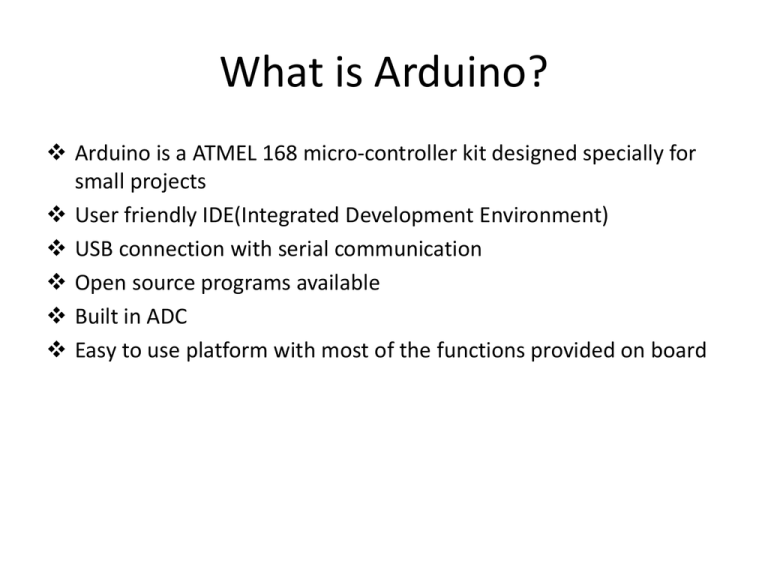Presentation_
advertisement

What is Arduino?
Arduino is a ATMEL 168 micro-controller kit designed specially for
small projects
User friendly IDE(Integrated Development Environment)
USB connection with serial communication
Open source programs available
Built in ADC
Easy to use platform with most of the functions provided on board
Introduction to Arduino
8 BIT DIGITAL PORT WITH
PWM PINS
USB CONNECTOR
FOR COMPUTER
INTERFACING
8 BIT DIGITAL PORT WITH
COMMUNICATION PINS
ON BOARD
CRYSTAL
RESET SWITCH
ATMEL 168
EXTERNAL SUPPLY
– 6V DC
POWER PORT
ADC PINS
Why Arduino?
Arduino has multiple inbuilt features and acts as a
combination of 10 bit analog to digital converter(ADC),
storage and microprocessor.
Arduino comes up with its own software for analyzing,
processing and calculation of unknown parameters.
It provides a facility to write programs, compile them
and program the microcontroller all by itself.
It can take 6 analog inputs and a time and process all of
them without any difficulty.
There are 2 digital 8 pin ports available and they can be
used for interfacing with LCD, LEDs, to drive an other
circuit and so on.
Sample programs
• ADC – Analog to Digital
Converter
Takes analogue input from
Potentiometer
Converts 0-5V analog
signal to 0-1023 Digital
values
Displays it on screen using
serial communication
Displays it on 16x 8 LCD
Analog to Digital Converter
• CODE :
• void setup() {
• Serial.begin(9600); //begin serial communication with
computer
• }
• //void loop runs continuously on µc
• void loop() {
• int sensorValue = analogRead(A0); //reads analogue pin
A0
• Serial.println(sensorValue, DEC); //prints it on serial
monitor
• }
LCD Interfacing
LCD Interfacing
•
•
CODE:
LiquidCrystal lcd(12, 11, 5, 4, 3, 2);
•
•
•
•
void setup() {
lcd.begin(16, 2); // set up the LCD's number of columns and rows:
lcd.print("hello, world!"); // Print a message to the LCD.
}
•
•
•
•
•
•
void loop() {
// set the cursor to column 0, line 1
// (note: line 1 is the second row, since counting begins with 0):
lcd.setCursor(0, 1);
lcd.print(millis()/1000); // print the number of seconds since reset:
}
LCD Output
Hardware is reduced
Microprocessor
Brain of the system
Analog
signal
ADC
Storage
10 bit built
in
4kb memory
connected
ARDUINO KIT
Input –
Output
ports
Usb port
of
computer
16 x 8
LCD
display
Frequency calculation for square wave
Firstly, a square wave is generated using a
555(timer circuit).
The values of R,C are adjusted such that the
frequency of output is
close to 60Hz.
This square wave signal is given to one of the
analog pins of Arduino.
Code for the frequency calculation is written,
verified and programmed using the Arduino
software.
The calculated frequency is displayed in the serial
monitor of the software or using an LCD.
Frequency calculation for square wave
ARDUINO
KIT
SERIAL
MONITOR
LCD
Measurement of live Power System
Frequency
Taking samples from actual 230V AC Supply
The Problem
POWER
SUPPLY
TRANSFORMER
230 V AC SIGNAL
OF 2.5 V DC
- 2.5 TO 2.5 V
&
ARDUINO
KIT
DC OFFSET
0-5 V DC SIGNAL
Live frequency estimation by Arduino
The live power signal of 230V magnitude is
stepped down by a transformer to 3V.
This AC signal of 3V is then fed to one of the
analog pins of Arduino.
Arduino microcontroller is able to read the input
only during its positive half cycle.
A set of 250 samples of this sinusoidal wave is
taken by the kit which has a sampling time
interval of .112ms.
As per the traditional zero cross-over method,
the frequency of the live signal is calculated.
Live frequency estimation by Arduino
Live AC
signal
230V/3V
Transformer
ARDUINO KIT
SERIAL
MONITOR
LCD
Taking all samples of the live signal
Since , the Arduino cannot be fed with an AC signal of high
magnitude, the signal is first brought to an AC wave of 6V
magnitude using a step down transformer.
This wave is given to the inverting pin of 741 Op-Amp IC using a
variable resistor such that the output due to this signal alone is 2V.
A dc voltage is fed to the non inverting pin of 741 so that the output
due to this signal alone is 3V.
This sinusoidal non AC signal varies from 0V to 5V.
This signal is finally given to one of the analog pins of the Arduino.
Analog-serial-input code is programmed into Arduino and samples
of the signal can be seen in the serial monitor every 1 ms.
•
Taking all samples of the live signal
ARDUINO
KIT
Serial
Monitor
Limitations of Arduino
Calculations of very high frequency signals is not
possible using Arduino as the sampling rate of ADC is
low.
The input signal must be non AC and must posses a
magnitude of less than 5V.
Heavy mathematical functions like inverse
trigonometry, modulus
• operation, complex equations cannot be performed by
the Arduino software.
• Thank you





